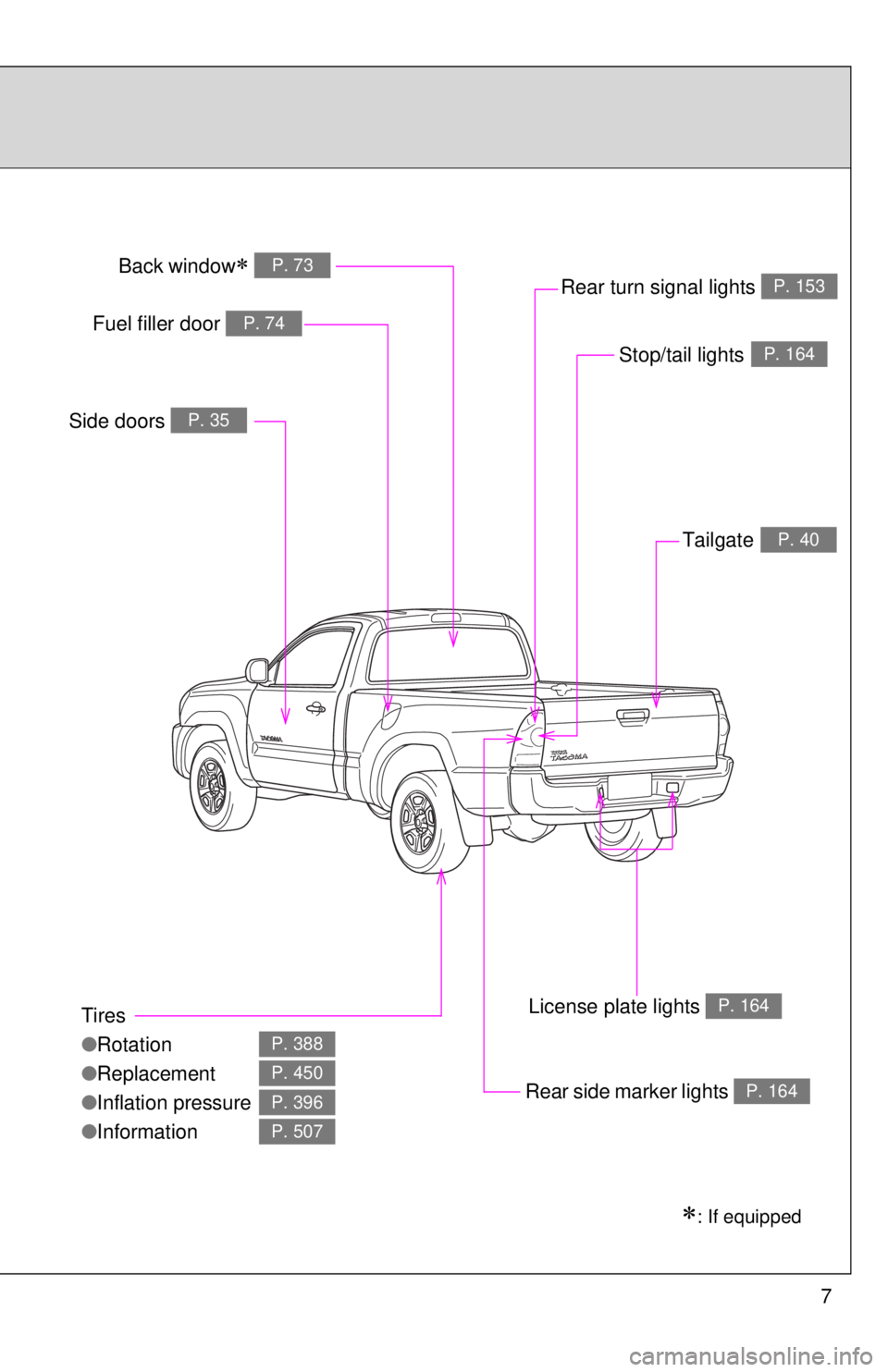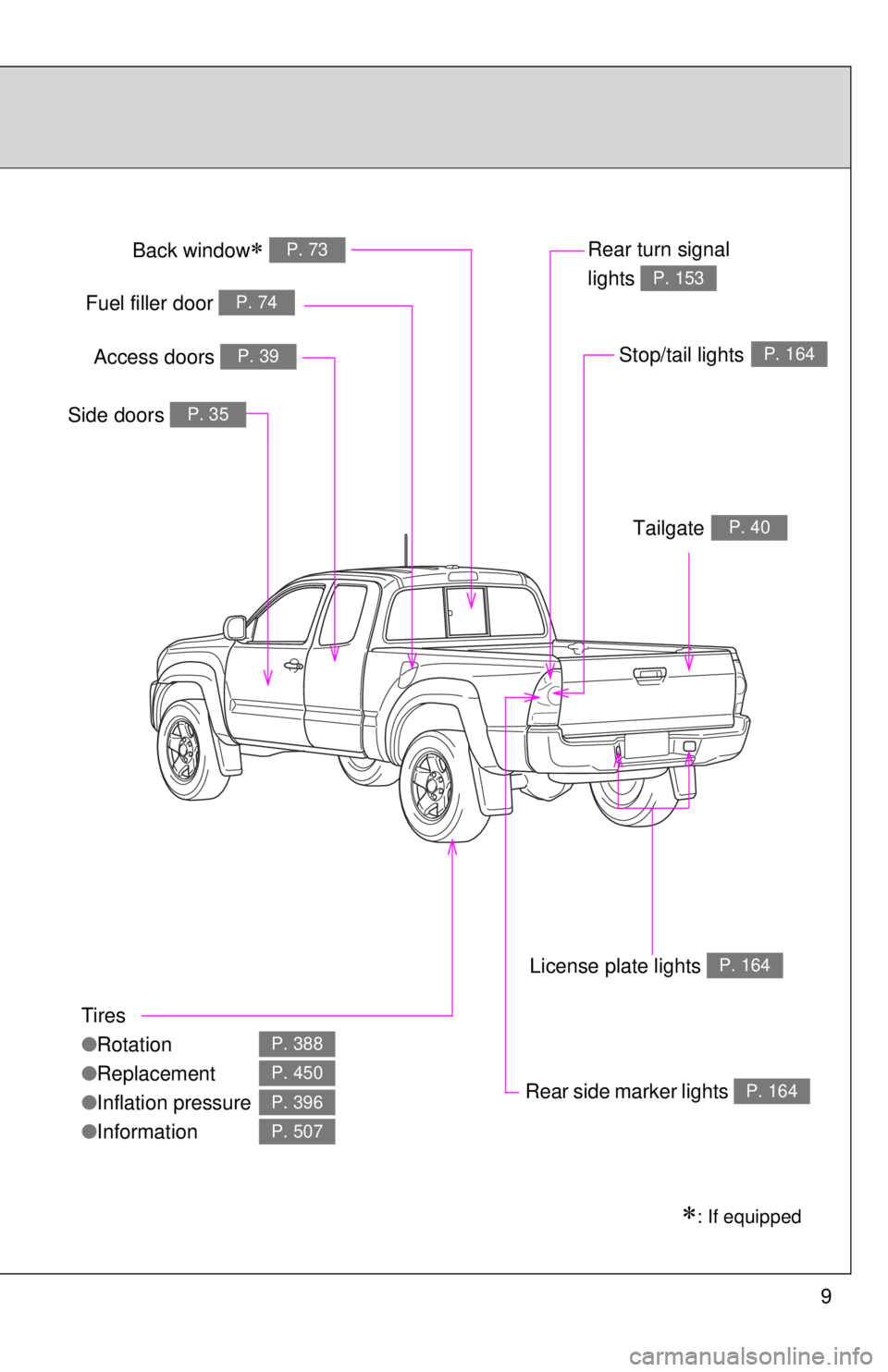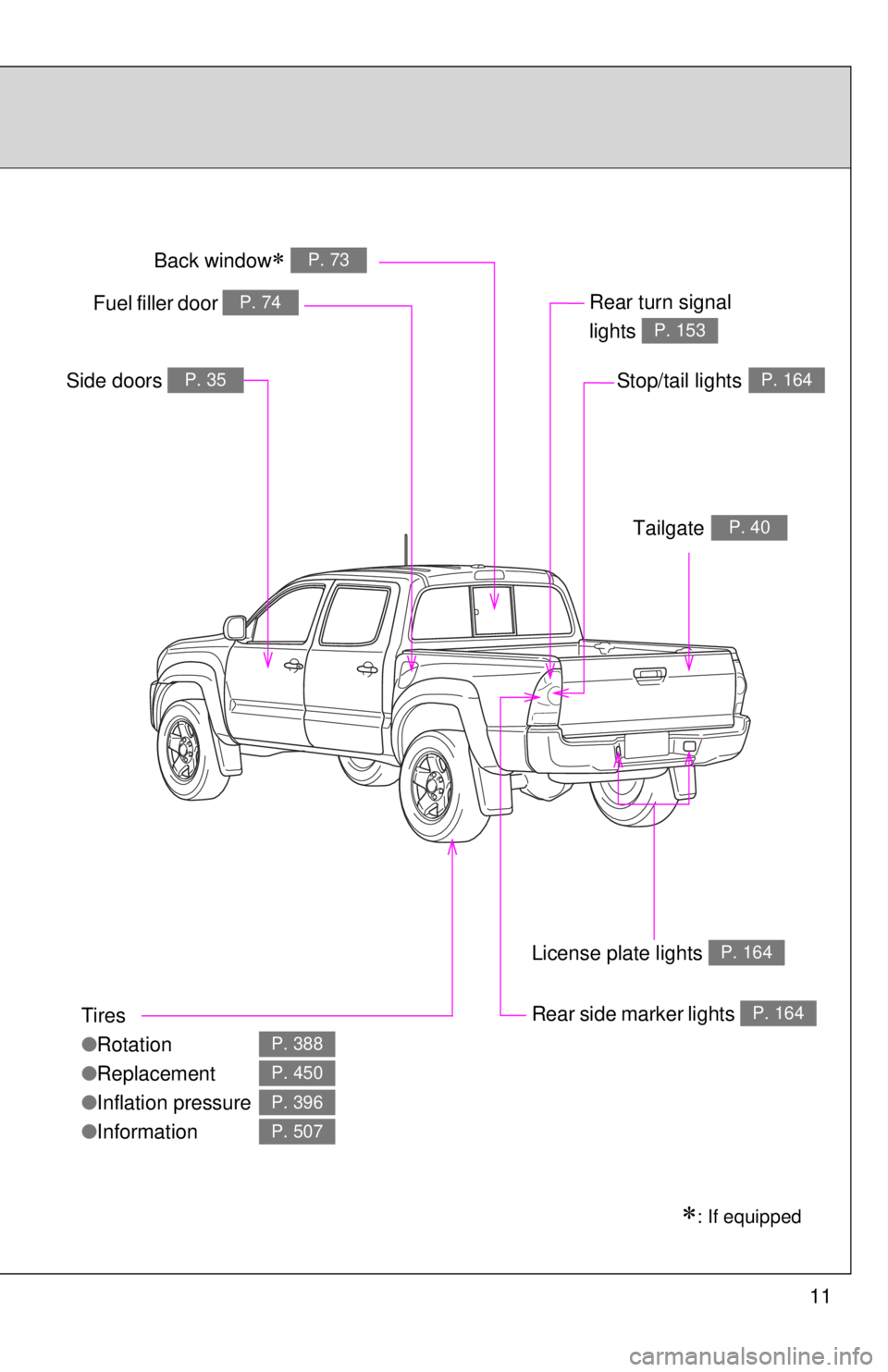tires TOYOTA TACOMA 2011 Owners Manual (in English)
[x] Cancel search | Manufacturer: TOYOTA, Model Year: 2011, Model line: TACOMA, Model: TOYOTA TACOMA 2011Pages: 548, PDF Size: 9.84 MB
Page 4 of 548

TABLE OF CONTENTSIndex
4
3-4. Using the interior lightsInterior lights list ................. 308
• Interior light ....................... 309
• Personal lights ................. 309
3-5. Using the storage features List of storage features....... 310
• Glove box ........................ 311
• Console boxes ................. 311
• Cup holders ...................... 312
• Bottle holders ................... 314
• Auxiliary boxes ................. 316
• Overhead console ............ 318
3-6. Other interior features Sun visors .......................... 319
Vanity mirrors ..................... 320
Clock .................................. 321
Outside temperature display (vehicles with accessory
meter) ............................... 322
Cigarette lighter .................. 323
Power outlet (12V DC) ....... 324
Power outlet (115V AC) ..... 325
Seatback table ................... 331
Floor mat ............................ 332
Luggage compartment features ............................ 334
Garage door opener box .... 343
Compass (vehicles with accessory meter).............. 347 4-1. Maintenance and care
Cleaning and protecting the vehicle exterior ........... 354
Cleaning and protecting the vehicle interior ............ 357
4-2. Maintenance Maintenance requirements .................... 360
General maintenance ......... 362
Emission inspection and maintenance (I/M)
programs .......................... 365
4-3. Do-it-yourself maintenance Do-it-yourself service precautions ....................... 366
Hood ................................... 370
Engine compartment .......... 372
Tires.................................... 388
Tire inflation pressure ......... 396
Wheels................................ 401
Air conditioning filter ........... 403
Wireless remote control battery .............................. 406
Checking and replacing fuses ................................. 408
Light bulbs .......................... 418
4Maintenance and care
Page 7 of 548

7
Tires
●Rotation
● Replacement
● Inflation pressure
● Information
P. 388
P. 450
P. 396
P. 507
Fuel filler door P. 74
Rear turn signal lights P. 153
Rear side marker lightsP. 164
Side doors P. 35
Stop/tail lightsP. 164
TailgateP. 40
License plate lights P. 164
Back window P. 73
: If equipped
Page 9 of 548

9
Tires
●Rotation
● Replacement
● Inflation pressure
● Information
P. 388
P. 450
P. 396
P. 507
Fuel filler door P. 74
Rear turn signal
lights
P. 153
Rear side marker lightsP. 164
Side doors P. 35
: If equipped
Stop/tail lightsP. 164
TailgateP. 40
License plate lights P. 164
Access doors P. 39
Back window P. 73
Page 11 of 548

11
Tires
●Rotation
● Replacement
● Inflation pressure
● Information
P. 388
P. 450
P. 396
P. 507
Fuel filler door P. 74Rear turn signal
lights
P. 153
Rear side marker lightsP. 164
Side doors P. 35
: If equipped
Stop/tail lightsP. 164
TailgateP. 40
License plate lights P. 164
Back window P. 73
Page 94 of 548

94 1-7. Safety information
CAUTION
■Modification and disposal of SRS airbag system components
Do not dispose of your vehicle or perform any of the following modifications
without consulting your Toyota dealer.
The SRS airbags may malfunction or deploy (inflate) accidentally, causing
death or serious injury.
● Installation, removal, disassembly and repair of the SRS airbags.
● Repairs, modifications, removal or replacement of the steering wheel,
instrument panel, dashboard, seats or seat upholstery, front, side and rear
pillars or roof side rails.
● Repairs or modifications of the front fender, front bumper, or side of the
occupant compartment.
● Installation of snow plows, winches, etc. to the front grille (bull bars, kan-
garoo bar etc.).
● Modifications to the vehicle’s suspension system.
● Do not use tires or wheels other than the manufacturer’s recommended
size. ( P. 500)
● Installation of electronic devices such as mobile two-way radios or CD
players.
● Modifications to your vehicle for a person with a physical disability.
Page 136 of 548

136 2-1. Driving procedures
Lightly depress the accelerator pedal at the same time as
gradually releasing the clutch pedal.
Release the parking brake.
■Driving in the rain
●Drive carefully when it is raining, because visibility will be reduced, the
windows may become fogged-up, and the road will be slippery.
● Drive carefully when it starts to rain, because the road surface will be
especially slippery.
● Refrain from high speeds when driving on an expressway in the rain,
because there may be a layer of water between the tires and the road
surface, preventing the steering and brakes from operating properly.
■ Breaking in your new Toyota
To extend the life of the vehicle, the following precautions are recommended
to observe:
●For the first 200 miles (300 km):
Avoid sudden stops.
● For the first 500 miles (800 km):
Do not tow a trailer.
● For the first 1000 miles (1600 km):
• Do not drive at extremely high speeds.
• Avoid sudden acceleration.
• Do not drive continuously in the low gears.
• Do not drive slowly with the manual transmission in a high gear.
• Do not drive at a constant speed for extended periods.
■ Operating your vehicle in a foreign country
Comply with the relevant vehicle registration laws and confirm the availability
of the correct fuel. ( P. 491)
Page 138 of 548

138 2-1. Driving procedures
CAUTION
■When driving the vehicle
●Do not shift the shift lever to N while the vehicle is moving.
Doing so may cause the engine brake to not operate properly and lead to
an accident.
● Do not turn the engine off while driving.
The power steering and brake booster systems will not operate properly if
the engine is not running.
● Use engine braking (downshift) to maintain a safe speed when driving
down a steep hill.
Using the brakes continuously may cause the brakes to overheat and lose
effectiveness. ( P. 147150)
● When stopped on an inclined surface, use the brake pedal and parking
brake to prevent the vehicle from rolling backward or forward and causing
an accident.
● Do not adjust the position of the steering wheel, the seat, or the inside or
outside rear view mirrors while driving.
Doing so may result in a loss of vehicle control that can cause accidents
that may result in death or serious injury.
● Always check that all passengers’ arms, heads or other parts of their bod-
ies are not outside the vehicle, as this may result in death or serious injury.
● Do not drive in excess of the speed limit. Even if the legal speed limit per-
mits it, do not drive over 85 mph (140 km/h) unless your vehicle has high-
speed capability tires. Driving over 85 mph (140 km/h) may result in tire
failure, loss of control and possible injury. Be sure to consult a tire dealer
to determine whether the tires on your vehicle are high-speed capability
tires or not before driving at such speeds.
■ When driving on slippery road surfaces
●Sudden braking, acceleration and steering may cause tire slippage and
reduce your ability to control the vehicle, resulting in an accident.
● Sudden changes in engine speed, such as engine braking caused by up-
shifting or down-shifting, may cause the vehicle to skid, resulting in an
accident.
Page 176 of 548

176 2-4. Using other driving systems
CAUTION
■When using the rear view monitor system
Observe the following precautions to avoid an accident that could result in
death or serious injuries.
● Never depend solely on the monitor system when reversing.
● Always check visually and with the mirrors to confirm your intended path is
clear.
● Depicted distances between objects and flat surfaces differ from actual
distances.
● Do not use the system if the tailgate open.
■ Conditions which may affect the rear view monitor system
● If the back of the vehicle has been hit, the camera’s position and mounting
angle may have changed. Have the vehicle inspected by your Toyota
dealer.
● As the camera has a water proof construction, do not detach, disassemble
or modify it. This may cause incorrect operation.
● Rapid temperature changes, such as when hot water is poured on the
vehicle in cold weather, may cause the system to function abnormally.
● If the camera lens is dirty, it cannot transmit a clear image. Rinse with
water and wipe with a soft cloth. If extremely dirty, wash with a mild
cleanser and rinse.
● Do not strongly rub the camera lens. If the camera lens is scratched, it
cannot transmit a clear image.
● Do not allow organic solvent, car wax, window cleaner or glass coat to
adhere to the camera. If this happens, wipe it off as soon as possible.
● The displayed image may be darker and moving images may be slightly
distorted when the system is cold.
● If the tires are changed, the area displayed on the screen may change.
● When washing the vehicle, do not apply intensive bursts of water to the
camera or camera area. Doing so may result in the camera malfunction-
ing.
Page 195 of 548

195
2-4. Using other
driving systems
2
When driving
CAUTION
■The ABS does not opera te effectively when
● The limits of the gripping performance have been exceeded.
● The vehicle hydroplanes while driving at high speed on the wet or slick
road.
■ Stopping distance when the ABS is operating will exceed that of nor-
mal conditions
The ABS is not designed to shorten the vehicle’s stopping distance. Always
maintain a safe distance from the vehicle in front of you in the following situ-
ations.
● When driving on dirt, gravel or snow-covered roads
● When driving with tire chains
● When driving over bumps in the road
● When driving over roads with pothol es or roads with uneven roads
■ When VSC is activated
The slip indicator flashes and a warning buzzer sounds. Always drive care-
fully. Reckless driving may cause an accident. Exercise particular care when
the indicator flashes and a buzzer sounds.
■ TRAC may not operate effectively when
Directional control and power may not be achievable while driving on slip-
pery road surfaces, even if TRAC is operating.
Do not drive the vehicle in conditions where stability and power may be lost.
■ If the hill-start assist contro l does not operate effectively
Do not overly rely on the hill-start assist control. The hill start assist control
may not operate effectively on steep inclines and roads covered in ice.
■ Replacing tires
Make sure that all tires are of the same size, brand, tread pattern and total
load capacity. In addition, make sure that the tires are inflated to the appro-
priate tire pressure level.
The ABS and VSC will not function correctly if different tires are fitted on the
vehicle.
Contact your Toyota dealer for further information when replacing tires or
wheels.
Page 196 of 548

196 2-4. Using other driving systems
CAUTION
■Handling of tires and suspension
Using tires with any kind of problem or modifying the suspension will affect
the driving assist systems, and may cause the system to malfunction.